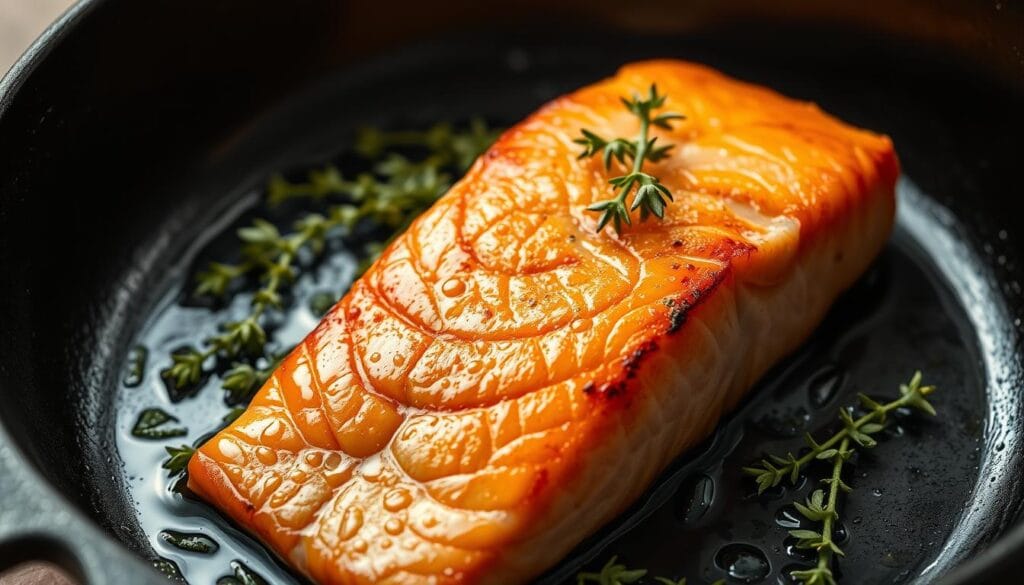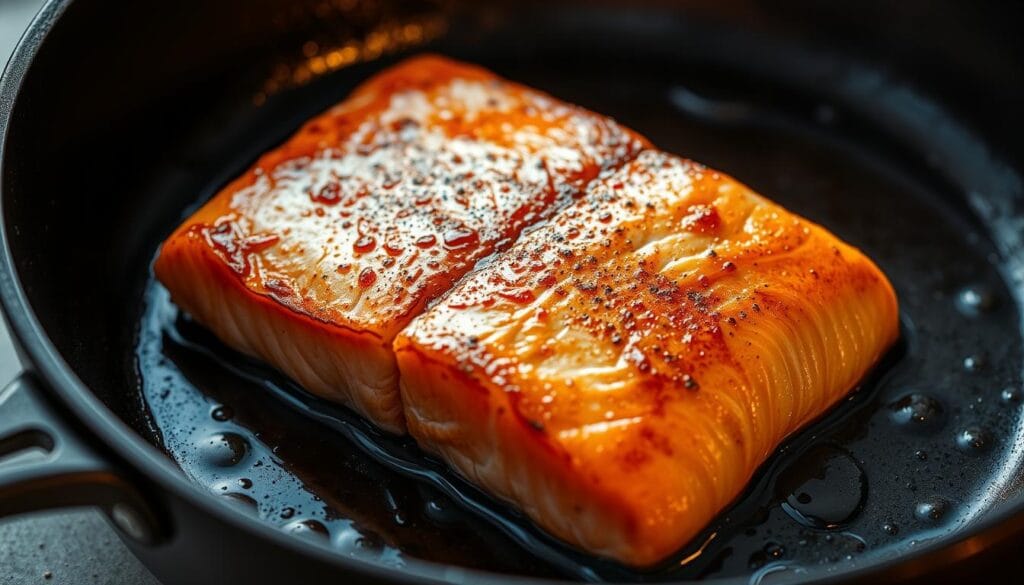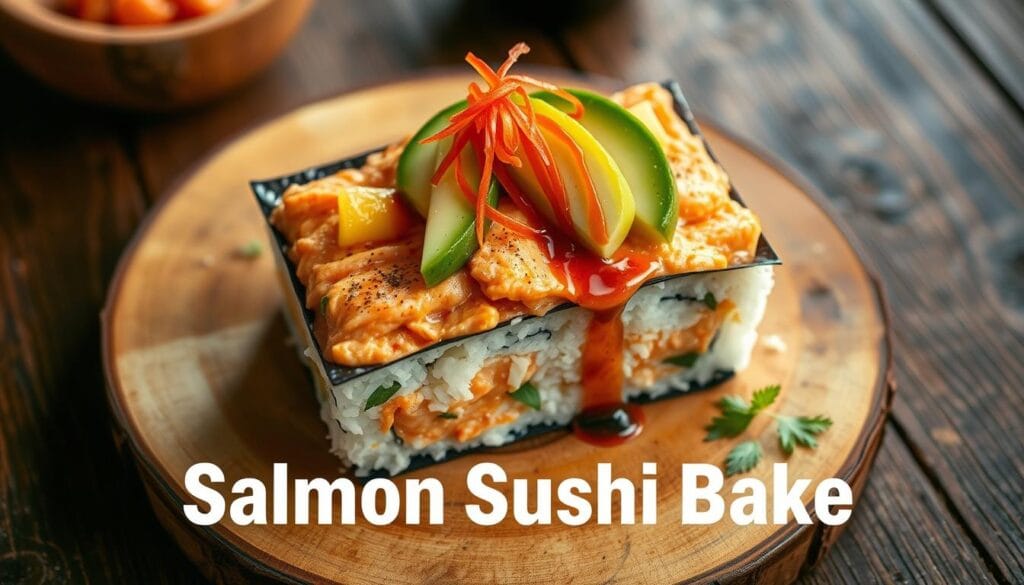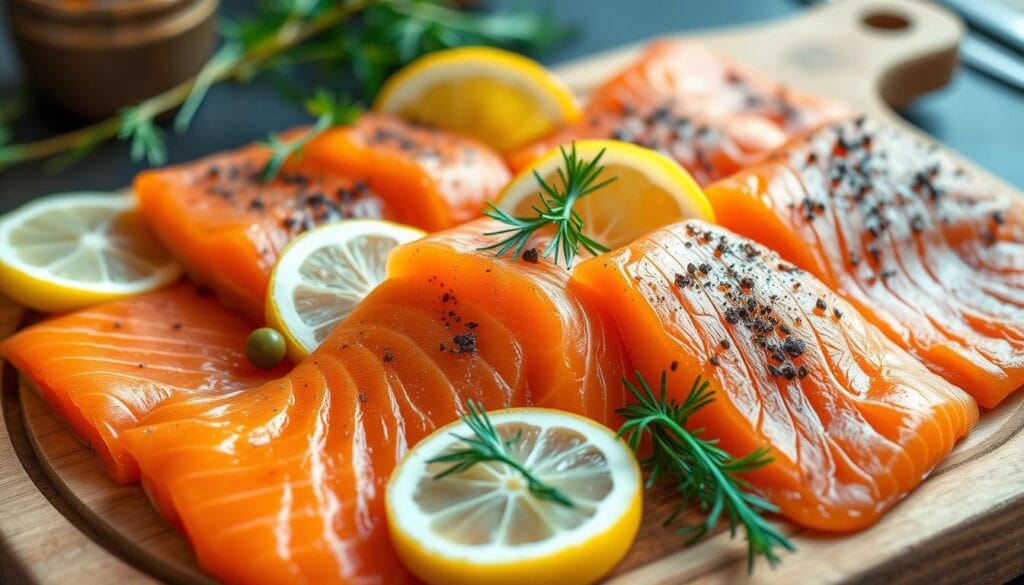Every home cook dreams of making salmon as good as a restaurant. They want it to have a golden, crispy outside and a tender, flaky inside. Mastering cast iron salmon is more than just cooking—it’s an art that makes any meal special.
Cast iron cooking is great because it keeps heat well and cooks evenly. It’s perfect for making perfectly seared salmon. Whether you’re new to cooking or have lots of experience, learning about salmon in cast iron can make you a better cook. It will impress even the pickiest eaters.
This guide will teach you everything about making restaurant-quality cast iron salmon. You’ll learn how to pick the right skillet and get that perfect golden crust. You’ll discover professional tips that turn simple fish into a delicious dish.
Imagine serving a salmon fillet with a crispy, caramelized outside. It will keep all the rich, delicate flavors inside. With the right approach, your cast iron salmon will be a meal that everyone remembers.
Table of Contents
Understanding the Magic of Cast Iron Cooking
Cooking salmon in a cast iron skillet turns a simple meal into a work of art. Cast iron’s special qualities make it perfect for cooking seafood, especially salmon.
Cast iron cookware has amazing benefits for cooking salmon. It retains and distributes heat well, creating a delicious sear.
Benefits of Cast Iron for Salmon Cooking
- Exceptional heat distribution
- Creates crispy exterior
- Locks in moisture
- Versatile cooking method
- Adds subtle iron-rich flavor
Why Cast Iron Creates the Perfect Sear
Learning to cook salmon in cast iron reveals its amazing searing abilities. The metal spreads heat evenly, making a golden crust while keeping the inside juicy.
Heat Distribution and Retention Properties
| Cast Iron Property | Cooking Benefit |
|---|---|
| High Heat Retention | Consistent cooking temperature |
| Even Heat Spread | Uniform salmon cooking |
| Natural Non-Stick Surface | Crispy skin without sticking |
Mastering cast iron cooking for salmon means understanding its heat properties. Your skillet becomes a powerful tool for making top-notch seafood at home.
Essential Equipment and Ingredients
To make the perfect pan seared salmon cast iron dish, you need the right tools and ingredients. Choosing the best equipment and ingredients turns a simple meal into a culinary masterpiece.
Choosing the Right Cast Iron Skillet
Your cast iron skillet is key to a great salmon dish. Look for these important features:
- 10-12 inch diameter for optimal cooking space
- Smooth, well-seasoned surface to prevent sticking
- Thick, heavy construction for even heat distribution
- Sturdy handle for safe maneuvering
Quality Salmon Selection Guide
Not all salmon is the same. Wild-caught salmon has better flavor and nutrition than farm-raised. When picking your fish, consider these points:
- Look for bright, vibrant color
- Check for firm, elastic flesh
- Ensure minimal fishy odor
- Choose fresh or properly frozen fillets
Required Seasonings and Oils
Use the right seasonings and oils to enhance your dish. Choose high smoke point oils like avocado or grapeseed oil. Good seasonings include:
- Sea salt
- Freshly ground black pepper
- Dill
- Garlic powder
- Lemon zest
“The secret to perfect salmon is quality ingredients and precise technique.” – Professional Chef
Investing in the right equipment and premium ingredients will make your pan seared salmon cast iron dish unforgettable.
Cast Iron Salmon Preparation Steps
Preparing salmon for cast iron cooking needs careful steps. Start by picking the right fish and preparing it right. The way you prepare it can greatly affect the taste and texture of your dish.
Before cooking salmon in a cast iron skillet, follow these key steps:
- Remove pin bones using clean tweezers
- Pat the salmon dry with paper towels
- Bring salmon to room temperature
- Select your preferred seasoning
Drying the salmon is key when cooking in cast iron. Too much moisture stops a good sear and makes the fish stick. Use paper towels to dry the fish well, helping it brown better.
| Preparation Step | Purpose | Recommended Time |
|---|---|---|
| Remove Pin Bones | Ensure smooth eating experience | 5-7 minutes |
| Pat Dry | Achieve crispy exterior | 2-3 minutes |
| Room Temperature | Even cooking | 15-20 minutes |
Your choice of seasoning can really boost the salmon’s flavor. Think about lemon-dill or a simple salt and pepper mix. Rub your seasonings gently over the fish to get even flavor.
Pro tip: Let your salmon rest at room temperature for about 15-20 minutes before cooking to ensure uniform heat penetration.
The Perfect Temperature Control Method
Mastering temperature control is key to a great cast iron salmon oven dish. The right heat makes your salmon perfectly cooked with a golden crust.

Temperature is crucial when cooking salmon in a cast iron skillet. You want consistent heat for even cooking and a beautiful sear.
Preheating Essentials
Good preheating is important for your cast iron salmon oven technique. Here are the essential steps:
- Preheat your cast iron skillet for 5-7 minutes
- Set oven temperature to 425°F
- Let salmon come to room temperature before cooking
- Use medium-high heat for the best sear
Maintaining Optimal Cooking Temperature
Keeping an eye on your salmon’s temperature is vital for perfect results. Here’s a temperature guide for precise cooking:
| Doneness Level | Internal Temperature | Cooking Time |
|---|---|---|
| Rare | 125°F | 3-4 minutes |
| Medium | 135°F | 4-5 minutes |
| Well Done | 145°F | 5-6 minutes |
Professional chefs suggest using a digital meat thermometer for accurate internal temperature checks. Remember, salmon continues cooking after being removed from heat, so take it out a bit before reaching your desired temperature.
Mastering the Searing Technique
Searing salmon in a cast iron skillet is an art. It turns a simple fish into a dish fit for a restaurant. The secret is in the golden-brown crust and the tender, juicy inside.
Begin by preparing your cast iron skillet with care. Make sure it’s hot before adding the fish. Pat the salmon dry – this step is key for a crispy crust.
- Use room temperature salmon for even cooking
- Ensure the skillet is hot before adding fish
- Place salmon skin-side down first
- Avoid moving the fish while it sears
When it’s time to sear, gently place the salmon fillets into the skillet. Make sure they don’t touch each other. This helps with even heat and prevents steaming. Press them lightly with a spatula for better contact.
Timing is crucial in pan seared salmon cooking. Sear for 3-4 minutes on the first side for a golden crust. Listen for the sizzle and watch for color changes. Flip when about 70% of the fish has changed color.
Pro tip: A well-seasoned cast iron skillet is your secret weapon for the perfect salmon sear.
Remember, practice makes perfect. Each time you cook, you’ll get better at timing and technique.
Achieving Crispy Skin Results
Getting crispy salmon in cast iron needs precision and skill. The salmon’s skin is key to making a dish special. It turns a simple meal into a work of art.

To get crispy salmon skin, follow some important steps. These will help you cook salmon in cast iron perfectly:
Skin-Side Down Cooking Technique
- Start with a dry salmon fillet
- Pat the skin well with paper towels
- Make sure your cast iron skillet is hot
- Put the salmon skin-side down first
Flipping Timing and Technique
Perfect salmon in cast iron needs patience and timing. Here’s what to do when cooking:
- Cook skin-side down for 4-5 minutes
- Check if the fish’s edges are turning opaque
- Test the skin’s crispiness gently
- Flip when the skin is golden and crispy
Pro tip: Never rush the skin-crisping process. The perfect crispy skin requires slow, controlled heat.
Your aim is to get a salmon fillet with a crispy outside and soft inside. With practice, you’ll make dishes as good as those in restaurants, right in your kitchen.
Common Mistakes to Avoid
Learning to cook salmon in a cast iron skillet can be tricky. Many people make mistakes that ruin the dish. These errors can stop you from getting a great sear and flavor.
Temperature control is key when cooking salmon in a cast iron skillet. Putting cold salmon fillets straight from the fridge into the pan is a big mistake. Cold fish cooks unevenly and can taste bad.
- Avoid overcrowding the pan – This prevents proper heat circulation and steams the fish instead of creating a crispy sear
- Never use oil with a low smoke point, which can burn and create bitter flavors
- Don’t flip the salmon too frequently – this disrupts the crucial crust formation
Getting your cast iron skillet ready is important for cooking salmon. Make sure it’s well-seasoned and hot before adding the fish. Many beginners skip this step, leading to poor results.
With practice, you’ll get better at cooking salmon in a cast iron skillet. Watch out for these common mistakes. Soon, you’ll be cooking like a pro.
Seasoning and Flavor Enhancement Tips
To make your cast iron salmon truly special, focus on seasoning and flavor. The right herbs and spices can turn your dish into a feast for the senses.
Learning to season cast iron salmon is key. You want to boost its flavor without overwhelming it. This way, the fish’s natural taste shines through.
Basic Seasoning Options
- Salt and black pepper for classic flavor
- Garlic powder for depth
- Onion powder for subtle sweetness
- Paprika for mild warmth
Advanced Herb Combinations
Professional chefs use herbs to make cast iron salmon stand out. Try these advanced pairings:
| Herb | Flavor Profile | Best Pairing |
|---|---|---|
| Thyme | Earthy and mild | Lemon-dressed salmon |
| Rosemary | Robust and pine-like | Garlic-infused preparations |
| Tarragon | Delicate and slightly sweet | Cream-based sauces |
Spice Intensity Tips
When cooking with cast iron salmon, remember that heat can make spices stronger. Start with a little cayenne or red pepper flakes. Then, add more to your liking.
Seasoning your cast iron salmon right will make it amazing. Try different flavors to find your favorite.
Storage and Reheating Guidelines
Keeping your cast iron salmon tasty and moist is key. After cooking, how you store and reheat it matters a lot. This ensures your salmon stays delicious.
Here’s how to store leftover cast iron salmon:
- Cool the salmon completely before storing
- Use airtight containers to prevent moisture loss
- Refrigerate within 2 hours of cooking
- Store in the refrigerator for up to 3 days maximum
Reheating your salmon needs care to avoid drying it out. The best way is to use your oven. It keeps the salmon moist and its texture just right.
“The key to great leftover salmon is gentle reheating and maintaining its original moisture.” – Professional Chef
Here’s how to reheat your cast iron salmon:
- Preheat your oven to 275°F (135°C)
- Place salmon in an oven-safe dish
- Add a splash of water or lemon juice
- Cover with aluminum foil
- Warm for 10-15 minutes until heated through
Pro tip: Avoid microwaving, as it can quickly dry out your delicate salmon and compromise its texture.
Conclusion
Cooking salmon in a cast iron skillet makes your kitchen feel like a pro kitchen. You’ve learned how to make pan seared salmon that rivals restaurants. This method gives you a crispy outside and a tender inside that wows everyone.
Getting better at cooking salmon takes practice. Each time, you’ll get better at controlling the heat, getting the perfect sear, and picking the right seasonings. Your cast iron skillet is key to making tasty, healthy meals that look great too.
Success with pan seared salmon comes from being patient and paying attention to details. Use top-notch salmon, preheat your skillet right, and focus on your technique. Try out different herbs and spices to find your favorite flavors. With effort, you’ll be making restaurant-quality salmon at home.
Cast iron cooking is versatile and fun. By practicing and learning, you’ll make delicious salmon dishes that everyone will enjoy. Your hard work will pay off with tasty meals that impress.
FAQ
What makes cast iron the best choice for cooking salmon?
How do I prevent the salmon from sticking to my cast iron skillet?
What’s the best way to get crispy salmon skin?
How long should I cook salmon in a cast iron skillet?
Can I use frozen salmon in a cast iron skillet?
What are the best seasonings for cast iron salmon?
How do I clean and maintain my cast iron skillet after cooking salmon?
What’s the difference between wild and farmed salmon for cast iron cooking?
Can I finish my salmon in the oven after searing in the cast iron skillet?
How do I store leftover cast iron salmon?
Did you like this recipe ?
There are no reviews yet. Be the first one to write one.


